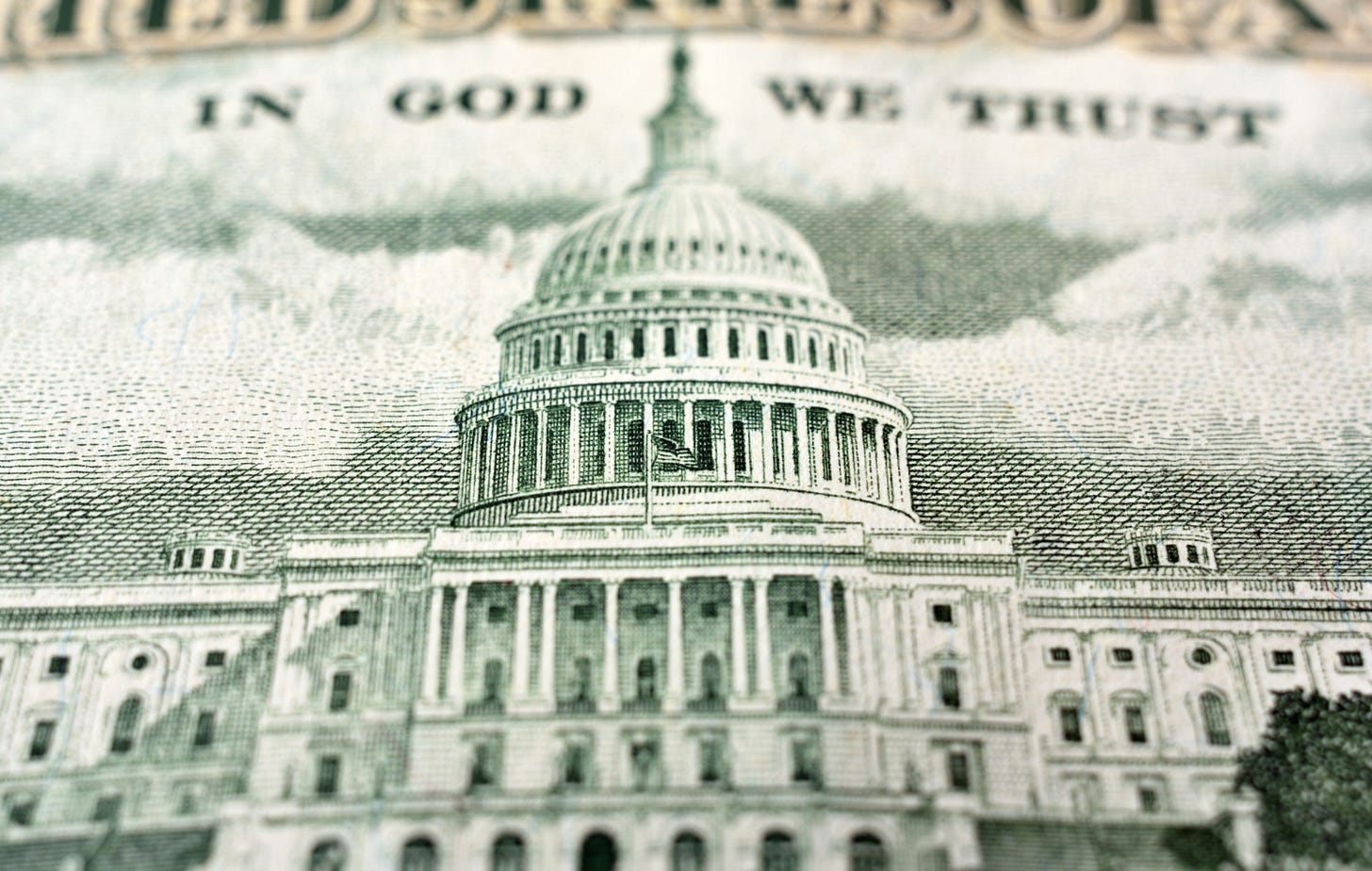Budget & Tariff "Uncertainty" Hits Americans | This Week's Economy Ep. 112
Tariffs, Texas budgets, and the Fed—what’s fueling uncertainty, and how to restore economic sanity.
Hello Friends!
Why does the economy feel so uncertain right now—and what can we do about it?
From Washington’s protectionist tariffs to Austin’s bloated budget, Americans feel the consequences of poor economic policy. Rising prices squeeze families, businesses struggle under new regulatory burdens, and taxpayers foot the bill for government expansion at every level.
Even with a 90-day pause on new tariffs, the fallout from former President Trump’s misguided trade policies continues to send shockwaves through the marketplace. From stock prices to oil markets and interest rates, businesses and policymakers are left in limbo, unsure how to plan without clear direction or reliable information. Meanwhile, as the Texas legislative session quickly ends on June 2, I’m reflecting on a deeply disappointing session for policy. Instead of building on the pro-growth, pro-market principles that made Texas a national leader, lawmakers have doubled down on bloated budgets and overbearing regulations.
In this week’s Let People Prosper Show, I discuss the big stories driving economic uncertainty and what real reform looks like. Watch the full episode on YouTube, Apple Podcast, or Spotify, and visit my website for more information.
1. STOCKS RALLY ON TARIFF PAUSE—BUT DON’T BE FOOLED

In the News:
Markets surged after the U.S. and China agreed to a 90-day pause on new tariffs. The Dow Jones Industrial Average jumped over 1,100 points, while the S&P 500 gained 3.3%, closing at its highest level since March 3. Source: NBC News and Reuters
My Take:
A Short-Lived Sugar High: The market rally may look encouraging, but let’s not be misled. Tariffs are still in place—and they’re nothing more than hidden taxes on American families, workers, and businesses. This temporary pause doesn’t change the underlying economic harm.
Uncertainty Comes at a Cost: Tariff policies fuel uncertainty, raise prices, and stoke inflation. Families already struggling with high grocery and energy bills are seeing their purchasing power erode even further. This unpredictability makes it nearly impossible to plan long-term investments or business growth.
What Real Reform Looks Like: If we want lasting prosperity, we need more than short-term deals. We need structural reforms: lower federal spending, permanent Trump-era tax cuts, fewer regulations, and a return to free trade with our allies. A better trade policy starts with ending protectionism and embracing mutually beneficial trade. That’s the path to a stronger economy—and a better future for all Americans.
Related: In a previous episode of This Week’s Economy, I explained how tariffs function as hidden taxes and fuel economic uncertainty.
2. TEXAS MUST NOT FALL BEHIND

In the News:
The 89th Legislature looks to pass the largest state budget in Texas history—$336 billion for FY 2026–27, up nearly 30% in four years and well above the average taxpayer’s ability to pay for it. A massive spending bill for public schools is on the table in HB 2, and a bad age-verification bill in SB 2420 is going to Governor Abbott’s desk. Source: The Center Square, Texas Tribune, Fox 7
My Take:
Texas Is Losing Its Way: This isn’t the Texas I’ve long admired for leading with freedom and economic strength as the 8th largest economy in the world. This legislative session has been filled with too many big-government policies, which should sound alarm bells.
Big Government, Small Liberty: Too much spending. Too little tax relief. Too much money is sitting in state savings accounts instead of circulating in the private sector. Too many bans are driven by fear. There is too much regulation of social media, AI, and financial institutions. And far too little effort to expand liberty and opportunity. Lawmakers look to fail to deliver true property tax relief and universal school choice, with just 1.5% of students able to receive funding. This is not the formula for a prosperous Texas.
Returning to Our Roots: For Texas to stay ahead, we must return to what made us strong: limited government, low taxes, fewer regulations, and a culture of personal responsibility and free enterprise. Texas must be Texas again.
Related: I recently visited the Texas Capitol and shared my thoughts on restoring the Rough Riders' spirit and the principles that built this great state.
3. Oil Prices & the Regulatory State

In the News:
Oil prices saw a modest rebound this week. Brent crude hovers around $65, with WTI just under $62. Meanwhile, Saudi Aramco—the world’s largest oil producer—reported declining profits but announced a $3.4 billion investment into its Motiva refinery in Texas, the largest fuel-making plant in the U.S. Sources: Transport Topics and Reuters
My Take:
What’s Really Going On: The recent price swings are driven by ongoing uncertainty and lingering supply chain constraints, some worsened by tariffs and other government interventions. Rising oil prices aren’t just about geopolitics—they’re a product of regulatory restrictions on production and refining.
Energy Regulations Are Holding Us Back: In the U.S., burdensome federal regulations and bureaucratic red tape hinder energy growth. America has largely achieved prosperity because it produces and uses energy more efficiently and responsibly than nearly any other nation. Yet policies like subsidies, tax breaks, and ESG mandates distort the market. If we want a resilient energy sector, we must trust the market—and let it work.
Texas Sets the Standard: Texas already leads the nation in renewable energy from subsidized wind and solar output. But the backbone of our energy grid remains reliable energy like natural gas, which powers homes and businesses in all weather conditions. We can still do more—streamlining local regulations, expanding transmission infrastructure, and encouraging innovation—to ensure Texas remains at the forefront of energy leadership. Federal and state policies must focus on energy abundance, not political agendas.
Related: Texas has what it takes to lead America toward energy independence—but only if we pursue market-driven solutions, not government control.
4. The Fed and Inflation Pressure

In the News:
The Federal Reserve held interest rates steady at 4.25% to 4.5% for the third consecutive meeting. However, markets remain skeptical. Ongoing uncertainty around President Trump’s tariffs, inflation pressures, and sluggish growth has left officials in a holding pattern. Meanwhile, the 10-year Treasury yield continues to climb, hovering around 4.45%. Sources: The New York Times and CNBC
My Take:
Reading Between the Lines: Inflation expectations remain embedded in the market despite the pause. The Fed manages “high-powered money,” composed mainly of Treasury securities from the trillions in federal debt. But monetary policy alone can't solve the problem.
The Real Culprit is Out-of-Control Spending: The real driver of persistent inflation is the Fed, but Congress’s overspending leads to more debt that the Fed purchases and creates inflation. Inflation is always a monetary phenomenon everywhere, but it’s often sparked by fiscal irresponsibility. Massive deficit spending fuels the Fed’s interventions, and Washington keeps feeding the fire.
Fixing Inflation at the Source: The Fed's hands are tied until we rein in federal spending and scale back regulatory overreach. Long-term inflation risk will remain unless we address the underlying cause: government excess.
Related: If Congress balanced the budget—a milestone we haven’t hit since 2001—it would remove one of the most dangerous tools the Fed can use against the economy. I wrote more about this in AIER’s The Daily Economy.
5. BUDGET RECONCILIATION: REFORM OR MORE DYSFUNCTION?

In the News:
Congress is moving forward with another budget reconciliation package. Committees are currently reviewing proposals to reform Medicaid, roll back Biden-era energy spending and regulations, extend the Trump tax cuts, modify the SALT deduction, and shift federal food assistance programs to the states. Sources: Roll Call and NPR
My Take:
What’s on the Table: We hear about tax reforms, “entitlement” changes, and possible spending reductions. Some of the most significant proposals involve Medicaid—introducing work requirements, tightening eligibility checks, and adjusting how states fund their share of the program.
Reform or More Dysfunction? Reconciliation should be an opportunity to reduce the size and scope of the federal government. If it’s not used to cut spending and decentralize power, it’s just more dysfunction. Congress must aim for real fiscal discipline—something we haven’t seen in recent budget efforts.
What Real Reform Looks Like: We need bold, structural change—not more budget gimmicks. That means adopting sustainable spending caps tied to population growth plus inflation. “Entitlement” programs should be converted into block grants to the states. And all federal programs should come with sunset provisions to ensure accountability and periodic review.
Related: I covered key elements of this bill in last week’s episode of This Week’s Economy. You can catch it here:
6. Healthcare Needs Market Reform, Not Price Controls

In the News:
Last week, President Trump signed an executive order requiring pharmaceutical companies to lower prescription drug prices—or face federal penalties. Source: Fox News
My Take:
Price Controls Don’t Work: Lowering prices may sound appealing, but price controls never work as intended. The push for price controls in healthcare ignores a basic economic truth: when you cap prices, you shrink supply, create shortages, lower quality, and increase black markets. The problem isn’t high prices—it’s too much demand chasing too little supply.
The Real Culprit Is Government: Bureaucrats can’t fix a system they helped break. For 80 years, well-meaning but destructive policies—starting with World War II-era wage controls that encouraged employer-provided health insurance—have kept healthcare from functioning as a true market.
The Path to Real Reform: The answer isn’t more mandates—it’s more freedom. We need to remove barriers, reduce red tape, and restore individual choice and responsibility in healthcare. Transparency, competition, and innovation—not price controls—are the keys to lower costs and better care.
Related: Price controls may sound good, but never work as intended. I explain in less than 30 seconds.
💬 Final Thoughts:
If we want lasting prosperity, we must get serious about the fundamentals: Free markets, not central planning. Spending limits, not budget bloat. Trade freedom, not protectionist tariffs. Choice and transparency, not healthcare price controls. The principles of sound economics haven’t changed. What’s changed is our willingness to follow them.
Texas should be leading with bold, pro-growth reforms. Instead, we're seeing more spending and missed opportunities. Nationally, the threat of new tariffs and continued overspending could tip an already fragile economy into recession. It’s time to return to principles that work.
Let’s choose freedom over fear, and prosperity over politics. Thanks for joining me in this episode of "This Week's Economy." For more insights, visit vanceginn.com and get even greater value with a paid subscription to my Substack newsletter at vanceginn.substack.com.
God bless you, and let people prosper!
Keep reading with a 7-day free trial
Subscribe to Let People Prosper to keep reading this post and get 7 days of free access to the full post archives.








